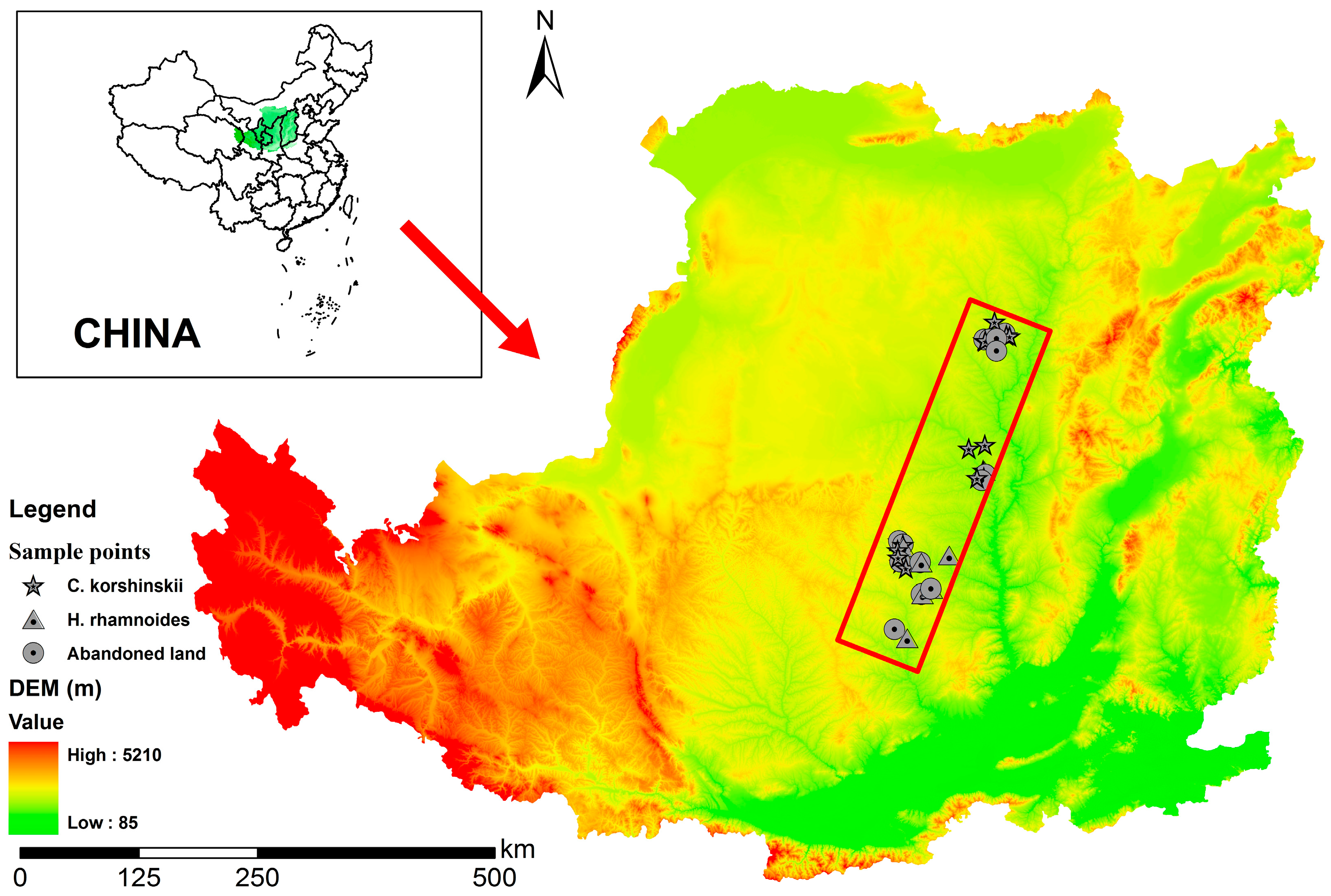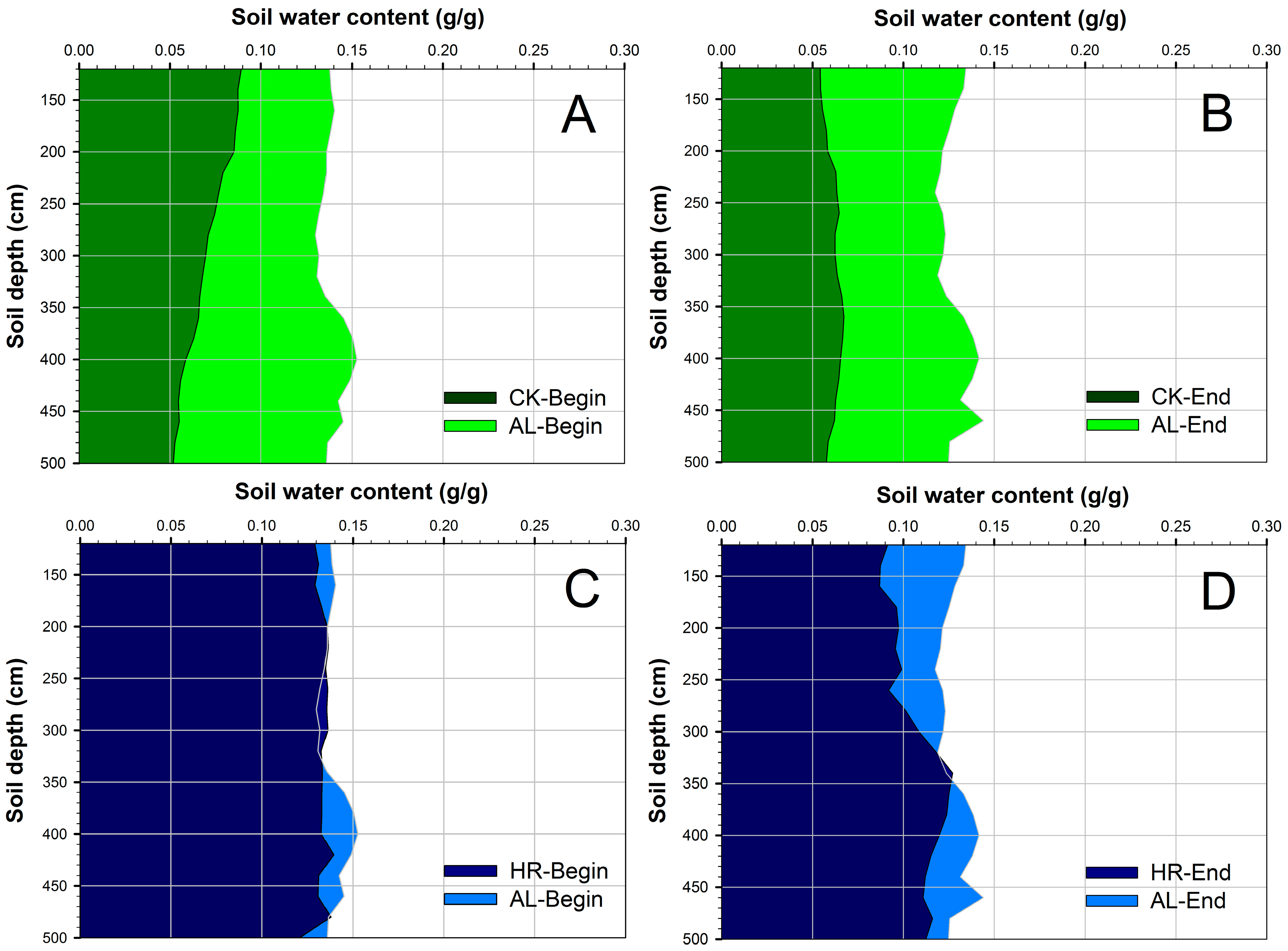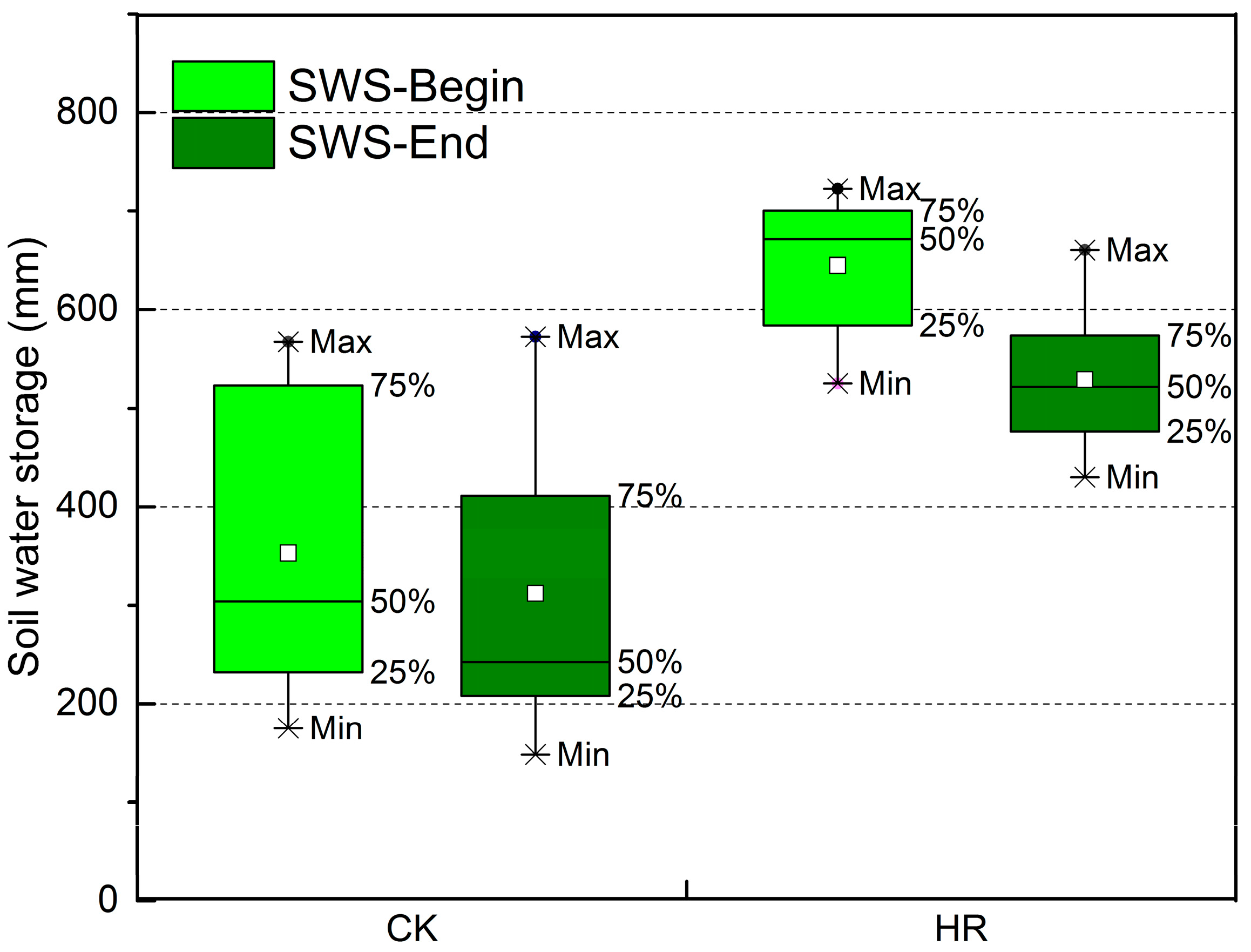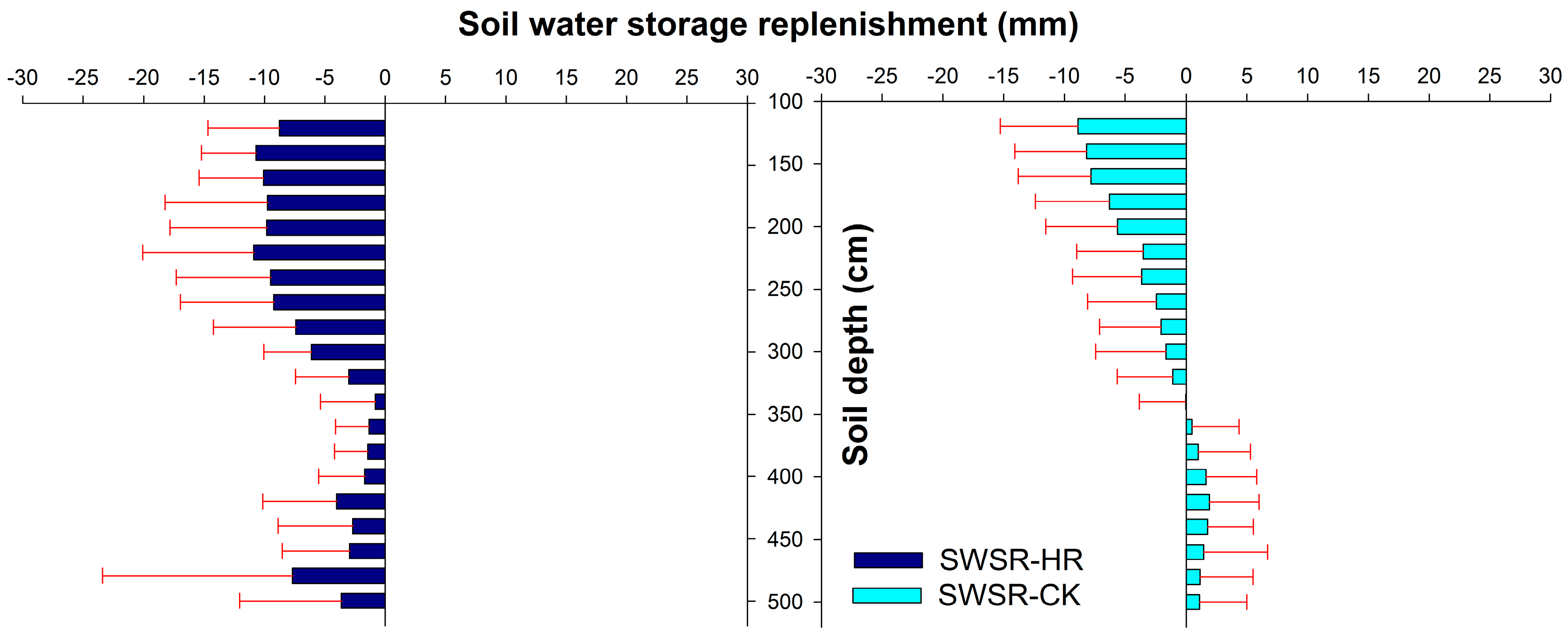Soil Water Storage Changes within Deep Profiles under Introduced Shrubs during the Growing Season: Evidence from Semiarid Loess Plateau, China
Abstract
:1. Introduction
2. Materials and Methods
2.1. Study Area
2.2. Field Sampling
2.3. Statistical Methods
3. Results
3.1. Soil Water Content of the Deep Profile under Introduced Shrubs and Abandoned Lands
3.2. Summary Statistics of Soil Water Storage Changes during the Growing Season
3.3. Factors Influencing Soil Water Storage Replenishment
4. Discussion
4.1. Relationships between Introduced Vegetation and Dried Soil in the Deep Profile
4.2. Factors Related to SWSR
4.3. Management Implications of the “Grain to Green Program”
5. Conclusions
Acknowledgments
Author Contributions
Conflicts of Interest
References
- Wang, L.; D’Odorico, P.; Evans, J.P.; Eldridge, D.J.; McCabe, M.F.; Caylor, K.K.; King, E.G. Dryland ecohydrology and climate change: Critical issues and technical advances. Hydrol. Earth Syst. Sci. 2012, 16, 2585–2603. [Google Scholar] [CrossRef]
- Ragab, R. Preface: Salinity management in agriculture: The basis and applications. In Manejo da Salinidade na Agricultura: Estudos Basicos e Aplicados; Gheyi, E.H.R., Dias, N.d.S., de Lacerda, C.F., Feitosa, C., Eds.; Institute Nacional De Ciencia E Tecnologia Em Salinidade: Fortaleza, Brazil, 2010. [Google Scholar]
- Daly, E.; Porporato, A. A review of soil moisture dynamics: From rainfall infiltration to ecosystem response. Environ. Eng. Sci. 2005, 22, 9–24. [Google Scholar] [CrossRef]
- Zhao, W.W.; Fu, B.J.; Chen, L.D. A comparison between soil loss evaluation index and the c-factor of rusle: A case study in the loess plateau of China. Hydrol. Earth Syst. Sci. 2012, 16, 2739–2748. [Google Scholar] [CrossRef]
- Zheng, H.; Gao, J.; Teng, Y.; Feng, C.; Tian, M. Temporal variations in soil moisture for three typical vegetation types in inner mongolia, northern China. PLoS ONE 2015, 10, e0118964. [Google Scholar] [CrossRef] [PubMed]
- Zavaleta, E.S.; Thomas, B.D.; Chiariello, N.R.; Asner, G.P.; Shaw, M.R.; Field, C.B. Plants reverse warming effect on ecosystem water balance. Proc. Natl. Acad. Sci. USA 2003, 100, 9892–9893. [Google Scholar] [CrossRef] [PubMed]
- Liu, Y.X.; Zhao, W.W.; Wang, L.X.; Zhang, X.; Daryanto, S.; Fang, X.N. Spatial variations of soil moisture under caragana korshinskii kom. From different precipitation zones: Field based analysis in the loess plateau, China. Forests 2016, 7, 31. [Google Scholar] [CrossRef]
- Lü, Y.H.; Ma, Z.M.; Zhang, L.W.; Fu, B.J.; Gao, G.Y. Redlines for the greening of China. Environ. Sci. Policy 2013, 33, 346–353. [Google Scholar] [CrossRef]
- Lü, Y.H.; Zhang, L.W.; Feng, X.M.; Zeng, Y.; Fu, B.J.; Yao, X.L.; Li, J.R.; Wu, B.F. Recent ecological transitions in China: Greening, browning, and influential factors. Sci. Rep. 2015, 5, 8732. [Google Scholar] [CrossRef] [PubMed]
- Montenegro, S.; Ragab, R. Impact of possible climate and land use changes in the semi arid regions: A case study from north eastern brazil. J. Hydrol. 2012, 434–435, 55–68. [Google Scholar] [CrossRef]
- Famiglietti, J.S.; Wood, E.F. Effects of spatial variability and scale on areally averaged evapotranspiration. Water Resour. Res. 1995, 31, 699–712. [Google Scholar] [CrossRef]
- Koster, R.D.; Dirmeyer, P.A.; Guo, Z.C.; Bonan, G.; Chan, E.; Cox, P.; Gordon, C.T.; Kanae, S.; Kowalczyk, E.; Lawrence, D.; et al. Regions of strong coupling between soil moisture and precipitation. Science 2004, 305, 1138–1140. [Google Scholar] [CrossRef] [PubMed]
- Quinn, P. Scale appropriate modelling: Representing cause-and-effect relationships in nitrate pollution at the catchment scale for the purpose of catchment scale planning. J. Hydrol. 2004, 291, 197–217. [Google Scholar] [CrossRef]
- Zhao, W.W.; Fu, B.J.; Qiu, Y. An upscaling method for cover-management factor and its application in the loess plateau of China. Int. J. Environ. Res. Public Health 2013, 10, 4752–4766. [Google Scholar] [CrossRef] [PubMed]
- Biswas, A. Landscape characteristics influence the spatial pattern of soil water storage: Similarity over times and at depths. Catena 2014, 116, 68–77. [Google Scholar] [CrossRef]
- Ferreira, J.N.; Bustamante, M.; Garcia-Montiel, D.C.; Caylor, K.K.; Davidson, E.A. Spatial variation in vegetation structure coupled to plant available water determined by two-dimensional soil resistivity profiling in a brazilian savanna. Oecologia 2007, 153, 417–430. [Google Scholar] [CrossRef] [PubMed]
- Geris, J.; Tetzlaff, D.; McDonnell, J.; Soulsby, C. The relative role of soil type and tree cover on water storage and transmission in northern headwater catchments. Hydrol. Process. 2015, 29, 1844–1860. [Google Scholar] [CrossRef]
- Grayson, R.B.; Western, A.W. Towards areal estimation of soil water content from point measurements: Time and space stability of mean response. J. Hydrol. 1998, 207, 68–82. [Google Scholar] [CrossRef]
- Schneider, K.; Huisman, J.A.; Breuer, L.; Zhao, Y.; Frede, H.G. Temporal stability of soil moisture in various semi-arid steppe ecosystems and its application in remote sensing. J. Hydrol. 2008, 359, 16–29. [Google Scholar] [CrossRef]
- Entin, J.K.; Alan, R.; Vinnikov, K.Y.; Hollinger, S.E.; Liu, S.; Namkhai, A. Temporal and spatial scales of observed soil moisture variations in the extratropics. J. Geophys. Res. 2000, 105, 11865–11877. [Google Scholar] [CrossRef]
- Han, X.; Tsunekawa, A.; Tsubo, M.; Li, S. Effects of land-cover type and topography on soil organic carbon storage on northern Loess Plateau, China. Acta Agric. Scand. 2010, 60, 326–334. [Google Scholar] [CrossRef]
- Qiu, Y.; Fu, B.; Wang, J.; Chen, L. Soil moisture variation in relation to topography and land use in a hillslope catchment of the Loess Plateau, China. J. Hydrol. 2001, 240, 243–263. [Google Scholar] [CrossRef]
- Liu, G.; Tian, G.; Shu, D.; Lin, S.; Liu, S. Streamflow and soil moisture of agroforestry and grass watesheds in hilly area. Pedosphere 2004, 14, 263–268. [Google Scholar]
- Stephen, S.O.B.; Mark, A.A.; Neil, C.T.; Don, A.W.; Chin, K.O. Tree roots: Conduits for deep recharge of soil water. Oecologia 2001, 126, 158–165. [Google Scholar]
- Wang, Y.; Shao, M.A.; Zhang, C.; Han, X.; Mao, T.; Jia, X. Choosing an optimal land-use pattern for restoring eco-environments in a semiarid region of the Chinese Loess Plateau. Ecol. Eng. 2015, 74, 213–222. [Google Scholar] [CrossRef]
- Geroy, I.J.; Gribb, M.M.; Marshall, H.P.; Chandler, D.G.; Benner, S.G.; McNamara, J.P. Aspect influences on soil water retention and storage. Hydrol. Process. 2011, 25, 3836–3842. [Google Scholar] [CrossRef]
- Yang, L.; Wei, W.; Chen, L.D.; Jia, F.; Mo, B. Spatial variations of shallow and deep soil moisture in the semi-arid loess plateau, China. Hydrol. Earth Syst. Sci. 2012, 16, 3199–3217. [Google Scholar] [CrossRef]
- Dai, Z. Intensive agropastoralism: Dryland degradation, the Grain-to-Green Program and islands of sustainability in the Mu Us Sandy Land of China. Agric. Ecosyst. Environ. 2010, 138, 249–256. [Google Scholar] [CrossRef]
- Feng, X.; Fu, B.; Lu, N.; Zeng, Y.; Wu, B. How ecological restoration alters ecosystem services: An analysis of carbon sequestration in China’s Loess Plateau. Sci. Rep. 2013, 3, 2846. [Google Scholar] [CrossRef] [PubMed]
- Lü, Y.H.; Fu, B.J.; Feng, X.M.; Zeng, Y.; Liu, Y.; Chang, R.Y.; Sun, G.; Wu, B.F. A policy-driven large scale ecological restoration: Quantifying ecosystem services changes in the Loess Plateau of China. PLoS ONE 2012, 7, e31782. [Google Scholar] [CrossRef] [PubMed]
- Chen, H.; Marter-Kenyon, J.; Lopez-Carr, D.; Liang, X.Y. Land cover and landscape changes in Shaanxi Province during China’s grain for green program (2000–2010). Environ. Monit. Assess. 2015, 187, 644. [Google Scholar] [CrossRef] [PubMed]
- Chen, Y.; Wang, K.; Lin, Y.; Shi, W.; Song, Y.; He, X. Balancing green and grain trade. Nat. Geosci. 2015, 8, 739–741. [Google Scholar] [CrossRef]
- Wang, Z.Q.; Liu, B.Y.; Liu, G.; Zhang, Y.X. Soil water depletion depth by planted vegetation on the loess plateau. Sci. China Ser. D Earth Sci. 2009, 52, 835–842. [Google Scholar] [CrossRef]
- Jin, Z.; Dong, Y.; Wang, Y.; Wei, X.; Wang, Y.; Cui, B.; Zhou, W. Natural vegetation restoration is more beneficial to soil surface organic and inorganic carbon sequestration than tree plantation on the Loess Plateau of China. Scie. Total Environ. 2014, 485–486, 615–623. [Google Scholar] [CrossRef] [PubMed]
- Liu, W.; Zhang, X.C.; Dang, T.; Ouyang, Z.; Li, Z.; Wang, J.; Wang, R.; Gao, C. Soil water dynamics and deep soil recharge in a record wet year in the southern Loess Plateau of China. Agric. Water Manag. 2010, 97, 1133–1138. [Google Scholar] [CrossRef]
- Yang, L.; Chen, L.; Wei, W.; Yu, Y.; Zhang, H. Comparison of deep soil moisture in two re-vegetation watersheds in semi-arid regions. J. Hydrol. 2014, 513, 314–321. [Google Scholar] [CrossRef]
- Chen, H.S.; Shao, M.A.; Li, Y.Y. Soil desiccation in the Loess Plateau of China. Geoderma 2008, 143, 91–100. [Google Scholar] [CrossRef]
- Hibbert, A.R. Water yield improvement potential by vagetation management on western rangelands. J. Am. Water Resourc. Assoc. 2007, 19, 375–381. [Google Scholar] [CrossRef]
- Wang, Y.Q.; Shao, M.A.; Zhu, Y.J.; Liu, Z.P. Impacts of land use and plant characteristics on dried soil layers in different climatic regions on the Loess Plateau of China. Agric. For. Meteorol. 2011, 151, 437–448. [Google Scholar] [CrossRef]
- Fan, J.; Gao, Y.; Wang, Q.; Malhi, S.S.; Li, Y. Mulching effects on water storage in soil and its depletion by alfalfa in the Loess Plateau of northwestern China. Agric. Water Manag. 2014, 138, 10–16. [Google Scholar]
- Ward, P.R.; Dunin, F.X.; Micin, S.F. Water use and root growth by annual and perennial pastures and subsequent crops in a phase rotation. Agric. Water Manag. 2002, 53, 83–97. [Google Scholar] [CrossRef]
- Cheng, X.; Huang, M.; Shao, M.; Warrington, D.N. A comparison of fine root distribution and water consumption of mature Caragana korshinkii kom grown in two soils in a semiarid region, China. Plant Soil 2008, 315, 149–161. [Google Scholar] [CrossRef]
- He, X.L.; Zhao, L.L.; Yang, H.Y. Diversity and spatial distribution of arbuscular mycorrhizal fungi of Caragana korshinskii in the Loess Plateau. Acta Ecol. Sin. 2006, 26, 3835–3840. [Google Scholar]
- Chen, H.S.; Shao, M.A.; Li, Y.Y. The characteristics of soil water cycle and water balance on steep grassland under natural and simulated rainfall conditions in the Loess Plateau of China. J. Hydrol. 2008, 360, 242–251. [Google Scholar] [CrossRef]
- Kimura, R.; Kamichika, M.; Takayama, N.; Matsuoka, N.; Zhang, X. Heat balance and soil moisture in the Loess Plateau, China. J. Agric. Meteorol. 2004, 60, 103–113. [Google Scholar] [CrossRef]
- Zhao, J.; Yan, X.; Guo, J.; Jia, G. Evaluating spatial-temporal dynamics of net primary productivity of different forest types in northeastern China based on improved FORCCHN. PLoS ONE 2012, 7, e48131. [Google Scholar] [CrossRef] [PubMed]
- Gao, X.; Wu, P.; Zhao, X.; Wang, J.; Shi, Y.; Zhang, B.; Tian, L.; Li, H. Estimation of spatial soil moisture averages in a large gully of the Loess Plateau of China through statistical and modeling solutions. J. Hydrol. 2013, 486, 466–478. [Google Scholar] [CrossRef]
- Fu, W.; Huang, M.; Gallichand, J.; Shao, M. Optimization of plant coverage in relation to water balance in the Loess Plateau of China. Geoderma 2012, 173–174, 134–144. [Google Scholar] [CrossRef]
- Sousa, S.; Martins, F.; Alvimferraz, M.; Pereira, M. Multiple linear regression and artificial neural networks based on principal components to predict ozone concentrations. Environ. Model. Softw. 2007, 22, 97–103. [Google Scholar] [CrossRef]
- Goncalves, F.L.; Carvalho, L.M.; Conde, F.C.; Latorre, M.R.; Saldiva, P.H.; Braga, A.L. The effects of air pollution and meteorological parameters on respiratory morbidity during the summer in Sao Paulo City. Environ. Int. 2005, 31, 343–349. [Google Scholar] [CrossRef] [PubMed]
- Shi, Y.G.; Wu, P.T.; Zhao, X.N.; Li, H.C.; Wang, J.W.; Zhang, B.Q. Statistical analyses and controls of root-zone soil moisture in a large gully of the Loess Plateau. Environ. Earth Sci. 2013, 71, 4801–4809. [Google Scholar] [CrossRef]
- Asbjornsen, H.; Goldsmith, G.R.; Alvarado-Barrientos, M.S.; Rebel, K.; Van Osch, F.P.; Rietkerk, M.; Chen, J.; Gotsch, S.; Tobon, C.; Geissert, D.R.; et al. Ecohydrological advances and applications in plant-water relations research: A review. J. Plant Ecol. 2011, 4, 3–22. [Google Scholar] [CrossRef]
- Li, Y. Intensification effects on soil anti-scourability by the sea buckthorn root system. J. Soil Water Conserv. 1990, 4, 15–20. [Google Scholar]
- Zhu, Y.; Wang, S.; Lin, Y.; Lu, Q. Development of caragana microphylla seedling root system in hilly regions of Loess Plateau. Bull. Soil Water Conserv. 2011, 31, 232–237. [Google Scholar]
- Oliveira, R.S.; Bezerra, L.; Davidson, E.A.; Pinto, F.; Klink, C.A.; Nepstad, D.C.; Moreira, A. Deep root function in soil water dynamics in cerrado savannas of central Brazil. Funct. Ecol. 2005, 19, 574–581. [Google Scholar] [CrossRef]
- Prieto, I.; Martinez-Tilleria, K.; Martinez-Manchego, L.; Montecinos, S.; Pugnaire, F.I.; Squeo, F.A. Hydraulic lift through transpiration suppression in shrubs from two arid ecosystems: Patterns and control mechanisms. Oecologia 2010, 163, 855–865. [Google Scholar] [CrossRef] [PubMed]
- Caldwell, M.M.; Dawson, T.E.; Richards, J.H. Hydraulic lift: Consequences of water efflux from the roots of plants. Oecologia 1998, 113, 151–161. [Google Scholar] [CrossRef]
- Horton, J.L.; Hart, S.C. Hydraulic lift: A potentially important ecosystem process. Trends Ecol. Evol. 1998, 13, 232–235. [Google Scholar] [CrossRef]
- Guan, X.; Yang, P.; Lü, Y. Relationships between soil particle size distribution and soil physical properties based on multifractal. Trans. Chin. Soc. Agric. Mach. 2011, 42, 44–50. [Google Scholar]
- Fu, L.; Sun, H.; Zhang, H.; Lei, X.; Lei, Y.; Tang, S. Effects of diameter at breast height on crown characteristics of Chinese fir under different canopy density conditions. Acta Ecol. Sin. 2013, 33, 2434–2443. [Google Scholar]
- Bormann, H. Assessing the soil texture-specific sensitivity of simulated soil moisture to projected climate change by SVAT modelling. Geoderma 2012, 185–186, 73–83. [Google Scholar] [CrossRef]
- Thomey, M.L.; Collins, S.L.; Vargas, R.; Johnson, J.E.; Brown, R.F.; Natvig, D.O.; Friggens, M.T. Effect of precipitation variability on net primary production and soil respiration in a chihuahuan desert grassland. Glob. Chang. Biol. 2011, 17, 1505–1515. [Google Scholar] [CrossRef]
- Sanchez-Mejia, Z.M.; Papuga, S.A.; Swetish, J.B.; van Leeuwen, W.J.D.; Szutu, D.; Hartfield, K. Quantifying the influence of deep soil moisture on ecosystem albedo: The role of vegetation. Water Resour. Res. 2014, 50, 4038–4053. [Google Scholar] [CrossRef]
- Shangguan, Z.P. Soil desiccation occurrence and its impact on forest vegetation in the Loess Plateau of China. Int. J. Sustain. Dev. World Ecol. 2007, 14, 299–306. [Google Scholar] [CrossRef]
- Wang, Y.Q.; Shao, M.A.; Liu, Z.P. Large-scale spatial variability of dried soil layers and related factors across the entire Loess Plateau of China. Geoderma 2010, 159, 99–108. [Google Scholar] [CrossRef]
- Wei, W.; Chen, L.; Yang, L.; Samadani, F.F.; Sun, G. Microtopography recreation benefits ecosystem restoration. Environ. Sci. Technol. 2012, 46, 10875–10876. [Google Scholar] [CrossRef] [PubMed]
- Xu, X.L.; Ma, K.M.; Fu, B.J.; Song, C.J.; Liu, W. Relationships between vegetation and soil and topography in a dry warm river valley, SW China. Catena 2008, 75, 138–145. [Google Scholar] [CrossRef]




| Sample Points | Age (Year) | Altitude (m) | Coverage (%) | Sand (%) | Silt (%) | Clay (%) |
|---|---|---|---|---|---|---|
| CK1 | 36 | 926 | 90 | 46 | 39 | 15 |
| CK2 | 37 | 969 | 80 | 33 | 56 | 11 |
| CK3 | 34 | 928 | 70 | 53 | 38 | 9 |
| CK4 | 32 | 926 | 53 | 64 | 31 | 5 |
| CK5 | 40 | 1075 | 38 | 35 | 56 | 8 |
| CK6 | 30 | 1258 | 68 | 59 | 28 | 13 |
| CK7 | 30 | 1245 | 43 | 23 | 65 | 12 |
| CK8 | 36 | 1215 | 73 | 21 | 69 | 10 |
| CK9 | 35 | 1049 | 80 | 35 | 53 | 12 |
| CK10 | 40 | 1198 | 68 | 50 | 45 | 5 |
| CK11 | 35 | 1232 | 70 | 30 | 56 | 13 |
| CK12 | 35 | 1340 | 45 | - | - | - |
| CK13 | 40 | 1290 | 79 | 64 | 30 | 6 |
| CK14 | 40 | 1383 | 58 | 51 | 44 | 5 |
| CK15 | 40 | 1243 | 50 | 61 | 29 | 10 |
| CK16 | 37 | 1264 | 50 | 45 | 35 | 20 |
| CK17 | 36 | 1245 | 65 | 70 | 20 | 9 |
| HR1 | 8 | 946 | 70 | 65 | 23 | 12 |
| HR2 | 5 | 1340 | 52 | 46 | 41 | 12 |
| HR3 | 5 | 1289 | 50 | 63 | 27 | 10 |
| HR4 | 5 | 1011 | 85 | 66 | 22 | 12 |
| HR5 | 9 | 1191 | 70 | 59 | 28 | 13 |
| HR6 | 10 | 1336 | 70 | 66 | 48 | 13 |
| HR7 | 7 | 1409 | 75 | 64 | 19 | 16 |
| HR8 | 6 | 1131 | 85 | 66 | 11 | 24 |
| AL1 | >30 | 874 | 25 | - | - | - |
| AL2 | >30 | 979 | 40 | - | - | - |
| AL3 | >30 | 1258 | 60 | - | - | - |
| AL4 | >30 | 1216 | 85 | - | - | - |
| AL5 | >30 | 1242 | 85 | - | - | - |
| AL6 | >30 | 1230 | 50 | - | - | - |
| AL7 | >30 | 1081 | 75 | - | - | - |
| AL8 | >30 | 1379 | 32 | - | - | - |
| AL9 | >30 | 1300 | 15 | - | - | - |
| AL10 | >30 | 1254 | 60 | - | - | - |
| AL11 | >30 | 1193 | 65 | - | - | - |
| AL12 | >30 | 1282 | 80 | - | - | - |
| AL13 | >30 | 1415 | 85 | - | - | - |
| AL14 | >30 | 1272 | 88 | - | - | - |
| VT | MAP | MAT | Alt | SG | SA | VC | CW | SP | BD | FC | SOC | Clay | Silt | Sand | |
|---|---|---|---|---|---|---|---|---|---|---|---|---|---|---|---|
| SWSR | −0.45 * | −0.18 | −0.21 | 0.09 | −0.18 | 0.15 | −0.14 | 0.29 | 0.04 | 0.10 | −0.53 ** | −0.41 * | 0.02 | −0.48 * | 0.48 * |
| SWSR1 | −0.34 | −0.18 | −0.32 | 0.03 | −0.19 | 0.15 | −0.12 | 0.23 | 0.08 | 0.04 | −0.58 ** | −0.50 * | 0.09 | −0.55 ** | 0.56 ** |
| SWSR2 | −0.47 * | −0.16 | 0.05 | −0.01 | 0.07 | −0.18 | −0.08 | 0.21 | 0.08 | 0.06 | −0.15 | −0.14 | −0.16 | −0.17 | 0.17 |
| VT | 1.00 | ||||||||||||||
| MAP | 0.58 ** | 1.00 | |||||||||||||
| MAT | 0.53 ** | 0.64 ** | 1.00 | ||||||||||||
| Alt | 0.13 | 0.51 ** | 0.02 | 1.00 | |||||||||||
| SG | −0.04 | −0.05 | 0.36 | −0.30 | 1.00 | ||||||||||
| SA | −0.16 | −0.33 | −0.07 | −0.37 | 0.25 | 1.00 | |||||||||
| VC | 0.21 | 0.12 | 0.27 | −0.35 | 0.09 | 0.13 | 1.00 | ||||||||
| CW | −0.12 | 0.15 | 0.01 | 0.30 | 0.16 | −0.24 | −0.43 * | 1.00 | |||||||
| SP | −0.02 | −0.14 | −0.07 | −0.12 | −0.08 | −0.20 | 0.09 | −0.31 | 1.00 | ||||||
| BD | −0.32 | −0.61 ** | −0.72 ** | −0.17 | −0.40 | 0.21 | −0.11 | −0.19 | 0.30 | 1.00 | |||||
| FC | 0.25 | 0.38 | 0.32 | 0.49 * | 0.11 | −0.39 | −0.15 | 0.18 | −0.11 | −0.22 | 1.00 | ||||
| SOC | 0.54 ** | 0.74 ** | 0.58 ** | 0.21 | 0.16 | −0.18 | 0.42 * | −0.10 | −0.21 | −0.42 * | 0.34 | 1.00 | |||
| Clay | 0.41 * | 0.51 * | 0.29 | 0.04 | −0.17 | 0.03 | 0.30 | −0.04 | 0.35 | −0.08 | −0.17 | 0.23 | 1.00 | ||
| Silt | 0.51 * | 0.56 ** | 0.71 ** | 0.08 | 0.31 | −0.17 | 0.17 | −0.07 | −0.02 | −0.60 ** | 0.44 * | 0.66 ** | 0.03 | 1.00 | |
| Sand | −0.50 * | −0.58 ** | −0.67 ** | −0.01 | −0.24 | 0.15 | −0.23 | 0.13 | −0.15 | 0.45 * | −0.34 | −0.61 ** | −0.30 | −0.90 ** | 1.00 |
| Variables | Component | ||||
|---|---|---|---|---|---|
| 1 | 2 | 3 | 4 | 5 | |
| VT | 0.60 | 0.26 | 0.35 | 0.15 | 0.05 |
| MAP | 0.72 | 0.45 | 0.42 | −0.11 | 0.17 |
| MAT | 0.88 | −0.11 | 0.16 | 0.00 | 0.04 |
| Alt | 0.09 | 0.82 | 0.05 | −0.21 | 0.15 |
| SG | 0.45 | −0.69 | −0.29 | −0.04 | 0.05 |
| SA | −0.23 | −0.58 | 0.11 | 0.32 | 0.38 |
| VC | 0.28 | −0.28 | 0.32 | 0.58 | 0.11 |
| CW | 0.00 | 0.09 | 0.08 | −0.86 | 0.20 |
| SP | −0.08 | −0.03 | 0.19 | 0.16 | −0.92 |
| BD | −0.77 | 0.09 | −0.01 | 0.35 | −0.23 |
| FC | 0.46 | 0.61 | −0.41 | 0.15 | −0.01 |
| SOC | 0.74 | 0.24 | 0.16 | 0.33 | 0.28 |
| Clay | 0.19 | 0.03 | 0.91 | 0.07 | −0.21 |
| Silt | 0.91 | 0.05 | −0.16 | 0.09 | −0.09 |
| Sand | −0.84 | −0.02 | −0.07 | −0.15 | 0.26 |
| Depth (cm) | Model | Variables | Coefficients | Standard Error | t-Value | Significance Level | Adjusted R2 |
|---|---|---|---|---|---|---|---|
| 100–500 | 1 | Constant | 68.73 | 53.18 | 1.29 | 0.21 | |
| Silt | −2.55 | 1.00 | −2.56 | 0.02 | 0.20 | ||
| 2 | Constant | −54.83 | 68.13 | −0.81 | 0.43 | ||
| Silt | −2.39 | 0.89 | −2.68 | 0.01 | |||
| CW | 0.75 | 0.30 | 2.54 | 0.02 | 0.35 | ||
| 100–340 | 1 | Constant | −148.89 | 29.26 | −5.09 | <0.01 | |
| Sand | 2.25 | 0.71 | 3.15 | <0.01 | 0.28 |
© 2016 by the authors; licensee MDPI, Basel, Switzerland. This article is an open access article distributed under the terms and conditions of the Creative Commons Attribution (CC-BY) license (http://creativecommons.org/licenses/by/4.0/).
Share and Cite
Liu, Y.; Zhao, W.; Zhang, X.; Fang, X. Soil Water Storage Changes within Deep Profiles under Introduced Shrubs during the Growing Season: Evidence from Semiarid Loess Plateau, China. Water 2016, 8, 475. https://doi.org/10.3390/w8100475
Liu Y, Zhao W, Zhang X, Fang X. Soil Water Storage Changes within Deep Profiles under Introduced Shrubs during the Growing Season: Evidence from Semiarid Loess Plateau, China. Water. 2016; 8(10):475. https://doi.org/10.3390/w8100475
Chicago/Turabian StyleLiu, Yuanxin, Wenwu Zhao, Xiao Zhang, and Xuening Fang. 2016. "Soil Water Storage Changes within Deep Profiles under Introduced Shrubs during the Growing Season: Evidence from Semiarid Loess Plateau, China" Water 8, no. 10: 475. https://doi.org/10.3390/w8100475
APA StyleLiu, Y., Zhao, W., Zhang, X., & Fang, X. (2016). Soil Water Storage Changes within Deep Profiles under Introduced Shrubs during the Growing Season: Evidence from Semiarid Loess Plateau, China. Water, 8(10), 475. https://doi.org/10.3390/w8100475






